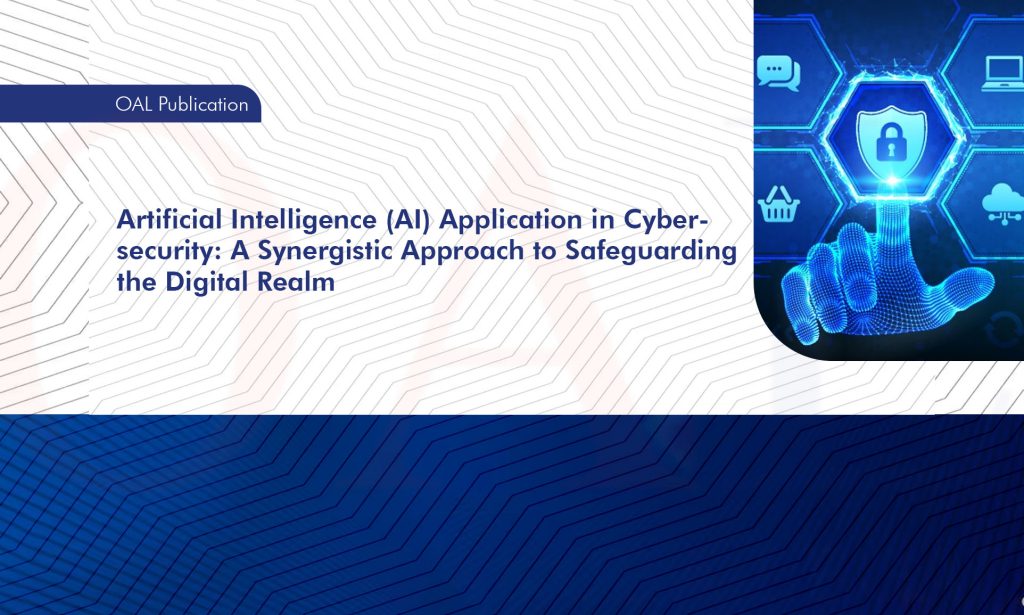Introduction:
Artificial Intelligence (AI) has emerged as a transformative force in various sectors, and one area where it has shown immense promise is cybersecurity. The rapidly evolving cyber threat landscape demands cutting-edge solutions, and AI has proven to be a game-changer in bolstering defense measures and promoting stability in cyberspace. This article explores the role of AI in strengthening cybersecurity solutions and emphasizes the importance of a synergistic integration between human intelligence and AI capabilities. It also delves into the real-world impact of AI in cyber defense and discusses the implications and ethical challenges that come with its adoption.
Artificial Intelligence (AI)’s Impact on Society
Artificial Intelligence (AI) has emerged as a technological marvel with profound ethical implications and societal benefits. Its adoption can drive global socioeconomic growth and address pressing challenges, including achieving the UN Sustainable Development Goals. By optimizing agricultural operations, revolutionizing transportation, combating climate change, and enhancing access to knowledge, AI holds the potential to create a better world.
According to Darrell M. West et. Al. (2018), one of AI’s key strengths lies in its analytical capabilities, enabling it to process vast amounts of data and identify patterns across domains and geographical boundaries. AI’s consistency, adaptability, and ability to handle repetitive tasks provide deeper insights and understanding into various scenarios. From streamlining travel and enhancing email spam filters for busy professionals to benefiting corporations, governments, and society, AI’s advantages are numerous.
In the realm of cybersecurity, AI emerges as a game-changer, particularly in countries like Nigeria. The integration of AI into homes, cars, and devices elevates their efficiency and intelligence. It offers the capability to distinguish malicious software and aids in creating a more peaceful and secure planet. AI’s adaptability and versatility enable it to overcome the limitations of traditional cybersecurity tools effectively.
Numerous companies leverage AI tools, such as machine learning, deep learning, and natural language processing, to empower security analysts in their fight against threats. AI’s ability to monitor user actions, identify network anomalies, and respond dynamically enhances cybersecurity professionals’ ability to investigate and mitigate cybercrimes. Machine learning, in particular, stands out for its prowess in swiftly detecting and neutralizing potential threats.
AI’s transformative capabilities extend beyond cybersecurity, influencing various aspects of society. In the realm of healthcare, AI enhances medical diagnosis and treatment, improves fetal health monitoring, and aids in predicting and managing epidemics and chronic illnesses. During the COVID-19 pandemic, AI played a pivotal role in studying the virus, accelerating medical research, developing vaccines, and disseminating critical information rapidly. In other fields, AI revolutionizes research methodologies and promotes scientific discoveries with far-reaching societal benefits. Education also stands to gain from AI’s personalized learning strategies, enabling greater accessibility to quality education.
Moreover, AI holds the potential to reinforce human rights by identifying and addressing biased judgments, tracking representation patterns in the media, and analyzing discriminatory organizational structures. By streamlining administrative processes, AI can enhance the rule of law and democracy, allowing public authorities to be more responsive to the needs of citizens and focus on complex issues. Additionally, AI assists policymakers in understanding public sentiments and informing decisions, leading to more effective and inclusive policies.
Therefore, AI’s profound impact on cybersecurity and various aspects of society is undeniable. Its potential to enhance efficiency, safety, and well-being makes it an indispensable tool in addressing global challenges. By harnessing AI’s capabilities responsibly and ethically, we can unlock its full potential for a brighter and more prosperous future. As we navigate the rapidly evolving landscape of AI, collaboration between governments, industries, and society will play a vital role in ensuring that this transformative technology benefits humanity.
Artificial Intelligence (AI) Application in Cybersecurity
The rapidly evolving landscape of cybercrime demands cutting-edge solutions to protect organizations from ever-evolving threats. In this battle, artificial intelligence (AI) has emerged as a game-changing technology, transcending traditional boundaries, and revolutionizing the way cybersecurity is approached. The integration of expert systems, neural networks, machine learning, data mining, and other AI technologies in cybercrime detection and prevention has opened new horizons in safeguarding digital assets.
AI’s Role in Strengthening Cybersecurity Solutions
AI-driven technologies are enhancing cybersecurity in four key areas: automated defense, cognitive security, adversarial training, and parallel and dynamic monitoring.
-
Automated Defense
The swift and automated detection of cyber threats is critical to safeguarding organizations in an era where attacks can cause havoc within minutes. AI empowers security professionals by training them to analyze the cyber environment and identify anomalies efficiently. Self-testing and self-healing software powered by AI bolster system robustness, allowing networks to maintain stability even in the face of erroneous inputs. The verification and validation processes can be seamlessly delegated to AI systems, ensuring continuous vigilance against potential threats.
-
Cognitive Security
The complexity of today’s cyber landscape demands a shift towards analytics-driven capabilities. AI shines in this domain by enabling systems to swiftly adapt to the ever-changing cloud computing platforms and respond to threats in the millisecond range. As organizations rapidly deploy and scale their services, AI steps in to provide intelligent and adaptive solutions, filling the gap left by traditional manual approaches.
-
Adversarial Training
AI’s ability to understand and counter adversarial tactics is a game-changer in the fight against cybercrime. By making threat and anomaly identification easier, AI bolsters system resilience, equipping organizations to withstand and endure attacks. This strategic approach to cybersecurity ensures that potential vulnerabilities are proactively addressed, mitigating the impact of potential attacks.
-
Parallel and Dynamic Monitoring
In an industry plagued by a global shortage of approximately 1.5 million cybersecurity professionals, AI-driven automation comes to the rescue. Organizations are forced to embrace AI solutions at a faster rate, utilizing the technology to monitor systems in real time. The dynamic monitoring capabilities of AI allow for proactive threat identification and immediate response, reducing the time gap between attack and defense.
A Synergistic Integration: Humans and AI
The utilization of AI in cybersecurity should not be seen as a replacement for human expertise but rather as a synergistic partnership. Just as police personnel collaborate with specialized police dogs to track down threats efficiently, AI systems complement security analysts to enhance the speed and efficiency of cyber operations. This symbiotic relationship preserves and amplifies the unique value that both humans and AI systems bring to the table.
Evidence and Real-World Impact
Several real-world cases illustrate the effectiveness of AI in bolstering cybersecurity. Organizations adopting AI-powered security measures have reported significant reductions in response time, mitigating potential damages caused by rapid cyber-attacks. For example, in a recent attack on a major financial institution, AI-based anomaly detection identified a sophisticated intrusion within minutes, allowing the security team to isolate and neutralize the threat promptly.
To summarize, as cyber threats continue to grow in frequency and complexity, the use of AI in cybersecurity has become indispensable. By bolstering automated defense mechanisms, enhancing cognitive security, enabling adversarial training, and offering parallel and dynamic monitoring, AI is reshaping the cybersecurity landscape. The synergy between human intelligence and AI capabilities creates a formidable defense against malicious actors, ensuring a safer and more resilient digital world.
In recognition of the profound impact AI has had on cybersecurity, organizations around the globe are increasingly embracing this technology as a critical pillar in their security infrastructure. The journey toward a safer digital realm has just begun, and AI is leading the way to a more secure and prosperous future.
Implications of Artificial Intelligence in Cybersecurity
In the rapidly evolving landscape of cybersecurity, the emergence of Artificial Intelligence (AI) has shown immense promise in bolstering defense measures and promoting stability in cyberspace. This groundbreaking technology holds the potential to revolutionize the way we approach cyber threats. However, as we delve into the implications of AI in cybersecurity, we must also address the ethical challenges that could hinder its full utilization and proper governance.
-
Enhancing System Robustness
One area where AI shines is in software testing, a burgeoning field focused on developing AI systems capable of testing software and self-healing. By harnessing AI for software verification and validation, human experts are liberated from tedious tasks, leading to faster and more accurate testing. Nonetheless, a significant question arises – who controls the AI system?
An ongoing debate centers around ensuring that key decisions about individuals, like profiling, are not solely left to autonomous systems. Organizations must define the boundaries where human control ends and automation begins. Furthermore, it is essential to establish mechanisms to guarantee that the AI system behaves as expected. The risk of outsourcing testing entirely to AI is the potential deskilling of cybersecurity professionals, akin to how doctors must still analyze X-ray scans to provide valuable insights when AI falls short.
Real-World Example: In a prominent case, a leading cybersecurity company implemented AI for software testing, which resulted in a substantial reduction in testing time and more efficient identification of vulnerabilities. However, human oversight remained essential, as some complex threats were beyond the scope of AI detection.
-
Boosting System Resilience
AI has seen significant adoption in threat and anomaly detection (TAD), leveraging historical security data to recognize patterns of vulnerabilities, viruses, and unusual behaviors. AI systems excel at detecting threats efficiently and rapidly, surpassing human capabilities. However, completely relying on AI for threat identification could lead to a general de-skilling of cybersecurity specialists.
Sophisticated cyberattacks often require human intervention for evaluating AI outcomes, aggregating alarms, reconstructing past assaults, and devising optimal responses. Cybersecurity specialists remain indispensable, just as radiologists must continue reading X-rays and pilots must land planes in case AI falters or misjudges.
Real-World Example: The US Navy’s response to the growing concern over cyberattacks on electronic navigation systems highlights the need for human expertise. They started retraining sailors in celestial navigation to complement AI-based systems, ensuring a reliable fallback in case of electronic navigation system failures.
To increase system resilience, AI demands intensive monitoring and data collection. However, this raises serious concerns about users’ privacy and the potential for data breaches, which could lead to mass surveillance and heightened risks.
-
Empowering System Responsiveness
AI empowers both attackers and defenders in the realm of cyber warfare. Attackers can utilize AI to enhance their targeting capabilities and develop complex attacks. On the other hand, AI also provides defenders with powerful tools for countermeasures and active cyber defense strategies.
Autonomous and semi-autonomous cybersecurity systems are now equipped with “playbooks” that contain predetermined reactions to assaults. Additionally, AI-enabled cyber weapons, such as autonomous malware, pose a new level of threat. IBM’s Deep-Locker prototype, an autonomous malware using neural networks for target selection and disguise, demonstrates the potential risks and capabilities.
Real-World Example: State actors have already started adopting active cyber defense tactics enabled by AI, raising questions about accountability and proportionality of responses.
Incorporating AI into defense strategies raises the critical question of responsibility. How do we assign obligations to autonomous response systems? Can we ensure accountability in an AI-driven defense landscape? The regulatory framework must address these concerns and define legitimate actors and targets.
Conclusion:
As cyber threats continue to evolve and become more sophisticated, the use of AI in cybersecurity is no longer a luxury but a necessity. AI-driven technologies, such as automated defense, cognitive security, adversarial training, and dynamic monitoring, offer a formidable defense against malicious actors, making the digital world safer and more resilient. The partnership between human expertise and AI capabilities creates a powerful combination that enhances cyber operations’ speed and efficiency. However, as AI’s role in cybersecurity expands, we must address the ethical challenges associated with its implementation. Striking a balance between AI-driven automation and human oversight is crucial to ensuring responsible and effective cyber defense strategies. By harnessing the potential of AI responsibly and ethically, we can build a safer and more prosperous digital future. Collaboration between governments, industries, and society will play a vital role in navigating the evolving landscape of AI in cybersecurity and realizing its full potential for the benefit of humanity.
AUTHOR:
Artificial Intelligence (AI) & Cybersecurity Writer
Author





